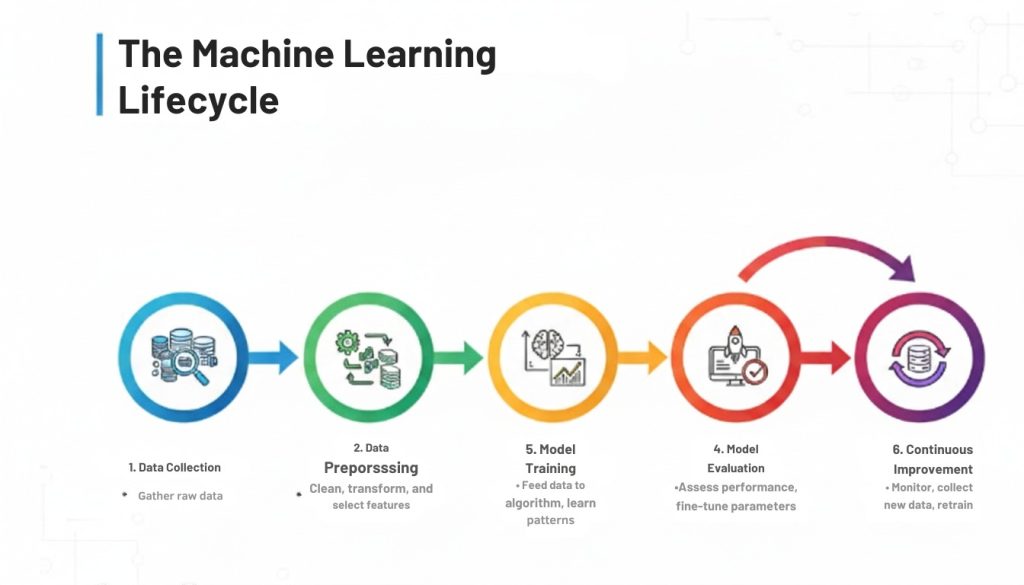
Have you ever wondered how Netflix recommends the perfect movie, or how Google Maps predicts the fastest route home? That’s the power of Machine Learning (ML). It is the invisible engine driving most of today’s AI systems. From voice assistants to self-driving cars, ML quietly works in the background, helping machines learn, adapt, and make decisions like humans.
What was once a futuristic dream is now an everyday reality, powered by algorithms that learn from data. Whether you’re scrolling through social media or asking Alexa to play your favorite song, you’re witnessing machine learning in action.
Let’s understand machine learning in more detail.
In the simplest terms, machine learning is a method that allows computers to learn and improve from experience without being explicitly programmed. Instead of following fixed instructions, ML systems identify patterns in data and use them to make predictions or decisions.
Think of it like this, instead of teaching a system every rule for recognizing spam emails, you show it thousands of examples. Over time, it learns the difference between spam and genuine messages. That’s ML: learning from data to make smarter choices.
Traditional programming relies on logic and rules. Machine learning, on the other hand, relies on data and experience, making it the brain behind AI systems capable of understanding language, recognizing images, and predicting outcomes.
To master the fundamentals of machine learning, including its types and essential tools, check out our comprehensive guide on ML types and tools.
In supervised learning, the model is trained using labeled data, where both input and output are known. It learns by comparing its predictions with the correct answers and improving over time. For example, predicting housing prices based on features like location and size.
Common algorithms include linear regression, decision trees, and support vector machines.
Here, the system learns from unlabeled data. It explores patterns, relationships, and groupings on its own; no predefined answers are provided. For example, grouping customers based on shopping habits or segmenting audiences for marketing.
Techniques like clustering and dimensionality reduction help businesses discover hidden insights from large datasets.
This type of ML uses trial and error. The system learns by interacting with an environment and receiving rewards or penalties based on its actions. For instance, training a robot to walk or an AI agent to play chess.

Reinforcement learning is widely used in robotics, gaming, and autonomous systems, where the algorithm continuously learns to optimize its actions for better results.
Today, the global machine learning market is valued at approximately USD 93.95 billion in 2025 and is projected to grow to around USD 1,407.65 billion by 2034, with a strong compound annual growth rate (CAGR) of about 35.09%. This impressive growth highlights machine learning’s expanding influence across industries and its critical role in powering modern AI systems.
Let’s look at some real examples:
Curious about the broader AI context? Check out our post on the difference between AI and ML to see how these technologies work together.
These systems don’t just execute commands; they learn from user behavior, adapt to new patterns, and deliver personalized experiences at scale.
In essence, machine learning transforms raw data into intelligence, enabling AI systems to see, speak, think, and predict like humans.
Building an ML model isn’t magic; it’s a structured process. Here’s how it typically works:

For instance, to predict rainfall, meteorologists collect years of weather data, train the model, and refine it over time to improve accuracy.
Each stage in this lifecycle contributes to building efficient, scalable, and intelligent AI systems that continuously evolve.
Machine learning adoption is accelerating across business sectors. Around 72% of surveyed companies in 2025 reported utilizing or developing ML applications. This widespread embrace reflects ML’s transformative impact on industries, driving smarter decisions and personalized experiences at scale.
ML algorithms analyze X-rays and MRI scans to detect diseases early. AI-driven diagnostics are even outperforming human doctors in some cases.
Banks use ML for fraud detection, credit scoring, and algorithmic trading. These systems can identify suspicious transactions within seconds. To see practical applications in finance, read our detailed guide on ML in finance and fraud detection.
E-commerce platforms rely on ML for product recommendations, price optimization, and customer sentiment analysis.
Ride-sharing apps and logistics companies use ML to optimize routes, predict demand, and reduce fuel consumption.
Personalized learning platforms use ML to adapt course materials to each student’s pace and understanding.
These examples prove that machine learning isn’t just about technology; it’s about making intelligent decisions at scale.
Machine Learning is the foundation of modern AI. Every intelligent tool we use today is powered by algorithms that learn, adapt, and improve continuously. And as the demand for AI-driven innovation grows, so does the need for individuals who understand how it works.
That’s where Gignaati comes in. We’re making AI education accessible to everyone, from curious beginners to professionals ready to build production-ready systems. Through hands-on masterclasses, live mentorship, and real-world AI projects, Gignaati helps you go from understanding to implementation.
Ready to kickstart your ML journey? Join Gignaati today and turn your curiosity into capability, because the future of AI begins with learning how machines learn.
Machine learning is when computers learn patterns from data and improve automatically, without being explicitly programmed for each task.
No. AI is the broader concept of smart machines, while machine learning is a subset that teaches them to learn from data.
Machine learning enables automation, smarter decision-making, and personalization across industries like healthcare, finance, retail, and transportation.
Basic knowledge of math, Python programming, and data handling helps, but structured guidance like Gignaati’s beginner courses makes learning easier.
Machine learning models get better as they process more data, recognize patterns, and adjust predictions through continuous learning.
Explore Gignaati.com – where top AI innovators showcase verified AI agents for real-world solutions.
© 2025 Gignaati is a product of Smartians.ai. All rights reserved.
Leave Your Comment